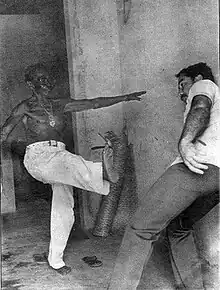Cobrinha Verde
Rafael Alves Franca (1912–1983), known as Cobrinha Verde (Little Green Snake) was capoeira mestre from mid-20th-century Brazil. He became one of the most feared and respected capoeiristas of his time.[1]

He is also considered one of the icons of the traditional capoeira Angola of his time.[2]
Biography
Rafael was born in Santo Amaro da Purificação and grew up playing capoeira on the streets.
He claimed Besouro was his first mestre but also his cousin and that he nicknamed him "Cobrinha Verde" because of his agility and dexterity, especially with his legs.
Besides Besouro, he also had the opportunity to learn from some of the most famous capoeiristas of that time, including Maitá, Licurí, Joité, Dendê, Gasolina, Siri de Mangue, Doze Homens, Espiridião, Juvêncio Grosso, Espinho Remoso, Neco, Canário Pardo, and Tonha. Alongside the rodas of Mestre Bimba, Mestre Pastinha, and Mestre Waldemar, this mestre's rodas was very influent in Brazil.[1]
He was a 3rd Sergeant in the old CR garrison in Campo Grande, and he also took part in the Revolution of 1930, among other events.
He gave classes in his sports Centre of Capoeira Angola Dois de Julho for many years, located in Alto de Santa Cruz, in the area of Nordeste de Amaralina (Casa Brito). He always taught capoeira for free because, as he said, his cousin Besouro made him promise never to charge money to teach the art of capoeira.[1]
Recordings
In 1962, film actor Roberto Batalin invited him to join Mestre Traíra and Mestre Gato in recording an album of capoeira songs of Bahia, which is now considered a masterpiece of capoeira.
In popular culture
During part of his life, he traveled widely and had interesting adventures, like following the band of outlaws led by Horace de Matos. In one of these adventures, as he told, armed with an 18-inch machete he faced eight policemen who opened fire on him. But he was able to divert all the bullets with his knife.[1] This and many other exploits were attributed not only to his agility and dexterity, but to magical secrets taught to him by an African named Pasquale who was a neighbor of his grandmother.[1]
References
- Cobrinha Verde
- Assunção 2002, pp. 154–155.
Works cited
- Assunção, Matthias Röhrig (2002). Capoeira: The History of an Afro-Brazilian Martial Art. Routledge. ISBN 978-0-7146-8086-6.